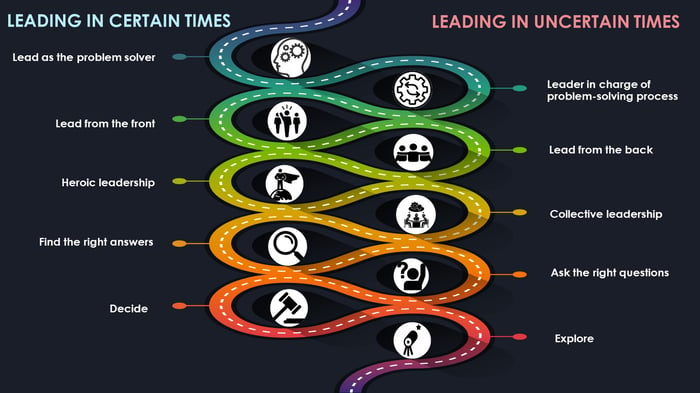Let me start with a startling statistic: 75 percent of the S&P 500 companies from 2012 will be entirely replaced by 2027. And here’s another one: the average company lifespan has dropped from 61 to 18 years over the past 60 years, and continues to shrink as competition rises in this disruption economy.
Leaders have never been faced with so much uncertainty. In order to adapt to this new volatile business climate, it’s no surprise that radical paradigm shifts are taking place in the world of leadership. And these changes can be painful for executives who are not prepared to let go of the old way of doing things.
Today, we will explore 3 key leadership paradigm shifts and how they are challenging the traditional sense of leadership, and how to become an effective leader in the age of disruption.

1) Leading in uncertain times
Leading when you know everything that is in stake is relatively easy. It can have its challenges, may require hard work and resilience, but the objectives are clearly set, and the methods needed to reach them are mastered.
But the Disruption Economy has created a lot of unknown factors in leadership, and leaders must face a “VUCA” (Volatile, Uncertain, Complex and Ambiguous) world. Today, objectives can be vague, targets moving, competition can also fly under the radar, technology can radically change any industry’s business model.
We can see this when we notice our own bosses seem at a loss. They have at best a vision but are unable to articulate the objectives as they had in the past. Welcome to the Disruption Economy. This is “Leading in uncertain times”.

Content leaders lead from the front, manage to gather a devoted, sometimes cult-like followership. Their licence to operate comes from their superior knowledge, genius, experience or intuition (see Steve Jobs, Jeff Bezos, Elon Musk).
Context leaders create intelligent organizations. They ensure knowledge is shared and intelligence is spread. They want people to connect with each other. Whereas a Content leader feels at ease in a pyramidal and hierarchical organization (if they sit on top of it), Context leaders will design organic networks, aligned on a shared purpose, reacting to permanent feedback with powerful relationships. The dictatorial, providential and heroic leader is out, the humble, connecting and inspiring one is in. In order to lead in this disruptive world, it’s essential to adopt a contextual leadership mindset.
2) Logos, Ethos & Pathos leadership
Disruptive leaders are aware that the days of clear objectives and known methodologies are over and that their task is to lead in the unknown. They need to go way beyond knowledge. They use these three levers to sustainable success (borrowed from Aristotle):
- Logos (Intellect): Engaging leaders make sure to co-create clarity, meaning and ownership around transformation, strategy, culture or organization they want to create. They understand that clarity cannot be imposed top down. Clarity is not a marching order. They offer time and space to their people so that those can make sense of the change.
- Ethos (Behaviors): Those leaders know that their credibility depends on their behaviour. They identify key critical behavioral changes to apply to themselves, which will prove to the organization that they are serious about their plans. Take the case of Dutch Prime Minister Mark Rutte, who leads by example, and not by perfection.
- Pathos (Emotions): They understand that moving people from intentions to actions requires the alignment of their emotions with the new situation. They master the use of stories, metaphors, symbols and gestures to impact their people’s emotional brain.
3) Leaders as partners
You cannot lead an organic and intelligent organization the same way you lead a pyramidal and hierarchical one. To lead intelligently requires adopting a collaborative attitude. Leaders who lead as partners strive for the following:
- They invite feedback, challenge and support from their partners (not colleagues) on how well their community (not silo) supports the group’s purpose.
- They “mind their colleagues’ business” not with a judgmental attitude but to help them, in a benevolent manner, to raise the level of their game.
- They are ready to step down from their actual functions to “join the ranks” and start again in another job, regardless of any hierarchical promotion/demotion consideration.
Learn more about the transforming role of leadership in our latest white paper, Emerging Trends in Leadership.
Didier Marlier is managing partner at Enablers Network, where he helps clients find disruptive strategies in an increasingly complex and chaotic business environment.
Hungry for more? Explore our latest insights on creating effective leaders today.








